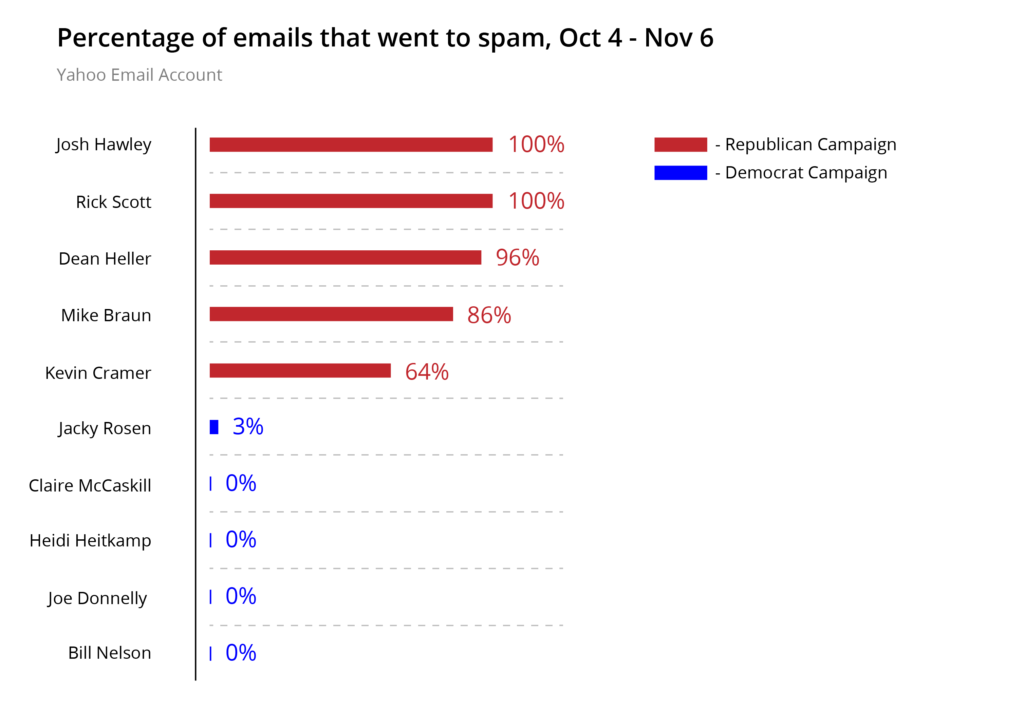via imge:
Is the world of email biased against conservatives? Many partisans often mutter such an accusation against Silicon Valley. Yet, few digital professionals take the time to investigate whether such a bold claim is true.
Poor email deliverability doesn’t just suppress a candidate’s message, it decreases the engagement of campaign supporters. That means fewer donations, fewer volunteers, and fewer advocates. If Republicans underperform in email deliverability, they face a disadvantage on Election Day.
So we decided to test the rumors. Our team created email addresses with different email providers and signed up for the email lists of around fifty different candidates, committees, and political nonprofits. In the month leading up to the election, we tracked how many emails were sent from each entity, and what percentage of those emails made it into our inbox. To keep it consistent, we opened every email, every day – regardless of where it was placed.*
Republicans Were Sent to Spam Far More Often Than Democrats
The results were striking, across every email provider.

To put these numbers in perspective, let’s examine two closely contested Senate races.
In Nevada, Democrat Jacky Rosen averaged over 90% placement in inboxes, compared to Dean Heller’s over 90% placement in spam.
In Florida, 100% of Republican Rick Scott’s emails went to spam in Yahoo, while 100% of Bill Nelson’s emails went to our Yahoo inbox.
While these were the most dramatic examples, this pattern emerged in every toss-up Senate race we tracked.

What Factors Might Play into Email Deliverability?
One might ask: well, were these conservatives spamming their supporters? Across the five toss-up Senate races we tracked, Democrats sent over four times the quantity of emails than their Republican opponents. Only one Senate candidate used a double opt-in, and it was a Republican: Kevin Cramer, who performed the best among the Republicans.
Making it into inboxes, however, takes more than sending the right amount of email. Email deliverability is a complex animal. List quality, content quality, knowledge of best practices, proper verifications – all of these factors feed into whether an email goes into the spam folder.
To be sure, some accusations of “bias” against conservatives on digital platforms can be attributed to a lack of digital sophistication. But these findings are consistent across multiple entities serviced by multiple professional firms. The answer to this disparity might be structural bias, bad strategy, or some blend of both. Regardless of the reason, it is clear that Republicans need to find this answer to remain competitive in email marketing.
Email marketing is a critical part of your digital strategy. At IMGE, we invest in the tools and tactics needed to run an effective campaign. Contact IMGE to learn more about how we make sure your email campaigns hit inboxes – not the spam folder.
Fine print for the nerds:
Our method for conducting this study was simple. First, we selected candidates from top party targets due to seat vulnerability. We leaned on Roll Call’s 10 Vulnerable House Members and Senators for candidate selection, and then added in party leadership and party committees. We added in three organizations from each side of the political aisle, as well as three non-partisan organizations, to round out our study. The full list can be found here.
Then we created four email addresses (Gmail, Yahoo, AOL, and Outlook) and signed up for their email lists. Most lists required an email and zip code, so we signed up with our Virginia office zip code so that we would be put on the national lists for all candidates.
To ensure consistency, we opened every single email in the inbox and spam folders, but we did not click on anything within the emails. We checked each inbox on a daily basis like most users would so that it would be as organic as possible. This study ran from October 4-November 6.
We tracked the following in spreadsheets:
1. Date we received the email
2. Sending URL/domain
3. Sender name
4. Sender email
5. Inbox placement (Inbox or Spam/Junk)
LinkedIn’s Reid Hoffman, the Alt Left, and Actual Election Interference
Oops: http://archive.li/d90xQ